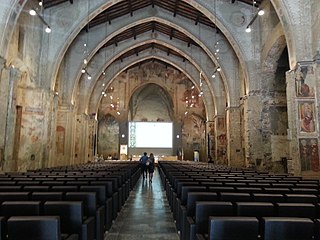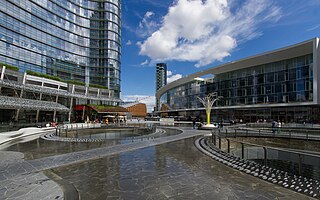
The University of Bologna is a public research university in Bologna, Italy. Teaching began around 1088, with the university becoming organised as guilds of students by the late 12th century, it is the oldest university in continuous operation in the world, and the first degree-awarding institution of higher learning. The university's emblem carries the motto, Alma Mater Studiorum, and the date A.D. 1088. With over 90,000 students, the University of Bologna is one of the largest universities in Europe.

The University of Milan, officially abbreviated as UNIMI, or colloquially referred to as La Statale, is a public research university in Milan, Italy. It is one of the largest universities in Europe, with about 60,000 students, and a permanent teaching and research staff of about 2,000.

The Galleria Vittorio Emanuele II is Italy's oldest active shopping gallery and a major landmark of Milan. Housed within a four-story double arcade in the centre of town, the Galleria is named after Victor Emmanuel II, the first king of the Kingdom of Italy. It was designed in 1861 and built by architect Giuseppe Mengoni between 1865 and 1877.

The United World College of the Adriatic is an international school in Italy, and a member of the United World Colleges, a global educational movement that brings together students from all over the world with the aim to foster peace and international understanding. The college is attended by around 180 students aged between 16 and 19, from around 80 countries, who live at the college for two years and study for the International Baccalaureate Diploma Programme.

The Polytechnic University of Milan is an Italian university located in Milan. It is the largest technical university in the country, with about 40,000 enrolled students. The university offers undergraduate, graduate, and higher education courses in engineering, architecture and design.

Higher education in Italy is mainly provided by a large and international network of public and state affiliated universities. State-run universities of Italy are under the supervision of Italian's Ministry of Education. There is also a number of private universities and state-run post-secondary educational centers providing a vocational instruction.

The University of Bergamo is an Italian public university located in Bergamo, Italy. It was founded on 11 December 1968 and is organized in seven departments, three campuses and forty-one degree courses.
Università Cattolica del Sacro Cuore, colloquially the Catholic University of Milan or simply the Cattolica, is an Italian private research university founded in 1921. Its main campus is located in Milan, Italy, with satellite campuses in Brescia, Piacenza, Cremona and Rome.

The University of Insubria is an Italian university located in Como and Varese, with secondary locations in Busto Arsizio and Saronno. It was founded in 1998, it has been named after the area where it is situated, the historical-geographical region of Insubria.

Richard Sapper was a German industrial designer who was based in Milan for much of his career. He is considered to be one of the most influential figures of post-war Italian design. His products typically feature a combination of technical innovation, simplicity of form, and an element of wit and surprise.

Roberto Longhi was an Italian academic, art historian, and curator. The main subjects of his studies were the painters Caravaggio and Piero della Francesca.

Carlo Ratti is an Italian architect, engineer, educator and author. He is a professor at the Massachusetts Institute of Technology where he directs the MIT Senseable City Lab, a research group that explores how new technologies are changing the way we understand, design and ultimately live in cities. Ratti is also a founding partner of the international design and innovation office CRA-Carlo Ratti Associati, which has offices in Turin, New York and London. He is also a Distinguished Professor in the Department of Architecture, Built Environment and Construction Engineering at the Politecnico di Milano and an Honorary Professor at TTPU Tashkent. Ratti was named one of the "50 most influential designers in America" by Fast Company and highlighted in Wired magazine's "Smart List: 50 people who will change the world".

The University of Milano-Bicocca is a public university located in Milan, Italy, providing undergraduate, graduate and post-graduate education. Established in 1998, it was ranked by the Times Higher Education 2014 ranking of the best 100 Universities under 50 years old as number 21 worldwide and first in Italy.

Dino Piero Giarda is an Italian economist and academia. He served as Minister without portfolio for Parliamentary Relations and Implementation of the Government Program in the Monti Cabinet.

The Zone 9 of Milan, since 2016 officially Municipality 9 of Milan, is one of the 9 administrative divisions of Milan, Italy.
Paolo Brescia is an Italian architect and founder of OBR Open Building Research.
Angelo Torricelli is an Italian architect.

Emanuela Setti Carraro was an Italian nurse and the wife of General Carlo Alberto dalla Chiesa. Less than two months after the marriage, she was the victim of the Sicilian Mafia in the Via Carini massacre that also killed her husband and the escorting officer Domenico Russo.

Eugenio Gentili Tedeschi (1916–2005) was an Italian architect, designer, teacher and writer active in Italian building and product design from the 1940s until his death in 2005. Through his popular lectures while professor of design at Milan Politecnico and through his numerous books, he influenced many of the designers and architects working in Italy and abroad today. The United States Holocaust Memorial Museum and the Jewish Partisan Educational Foundation have recognized Gentili for his actions in the Italian Resistance in the Val d'Aosta during World War 2. His architectural legacy in the form of buildings can be seen in Milan and elsewhere in Italy today.
Milano Innovation District (MIND) is the name given to the project dedicated to the area where Expo 2015 took place in Milan.




















